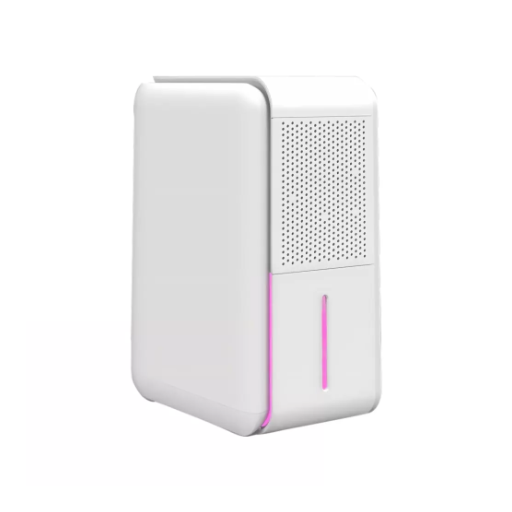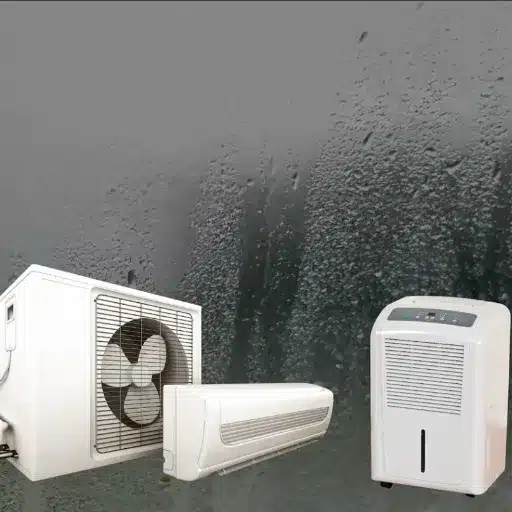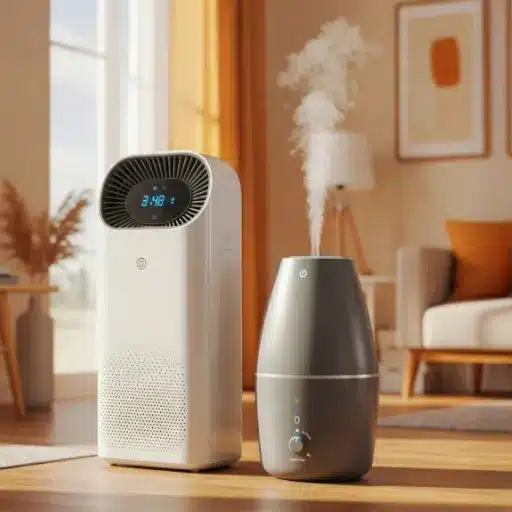Maintaining clean and comfortable air in your home is essential for health and overall well-being, but with so many options available, it can be challenging to know which device meets your specific needs. Humidifiers, dehumidifiers, and air purifiers are all popular choices, yet each serves a distinct purpose and addresses different aspects of indoor air quality. This article will help you understand the unique roles of these devices, so you can make an informed decision about which one is right for your home.
Understanding the Devices
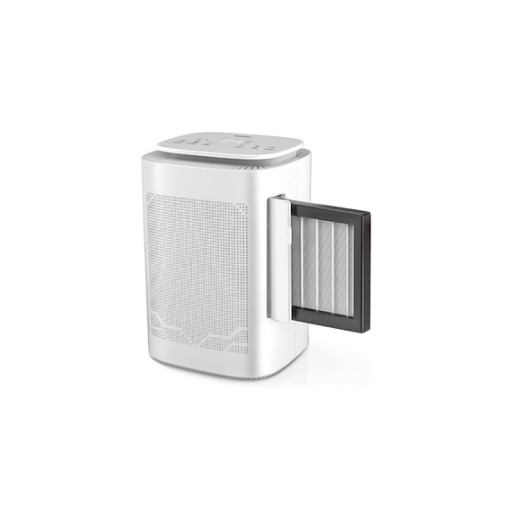
What is a Humidifier?
A humidifier is generally a household device that adds moisture to the air, rendering the environment comfortable during dry weather. It is used widely in cooler months as heating systems tend to dry indoor air. By adding moisture in the air, a humidifier acts against dry skin, against irritation in the sinuses, and other things that come with very low humidity levels.
Key Benefits:
- Protects wooden furniture, floors, and musical instruments from cracking or warping
- Helps with respiratory conditions like asthma, allergies, and the common cold
- Reduces dry cough and congestion
- Prevents dry skin and sinus irritation
There are several types of humidifiers available, such as cool mist, warm mist, ultrasonic, and evaporative. Picking an appropriate humidifier depends on room size, personal preference, and specific needs. Whatever their type, regular cleaning and maintenance of your humidifier is imperative to avoid mold and bacteria buildup, which ultimately keeps the air you breathe clean and healthy.
What is a Dehumidifier?
Dehumidifiers reduce or maintain humidity levels in the air, usually for comfort. By taking excess moisture out of the atmosphere, they create a dry environment that can prevent many problems associated with high moisture, like fungal growth, musty odors, and dust mites. Dehumidifiers can operate in houses, basements, offices, and places wherein the humidity level generally stays high.
Key Benefits:
- Prevents mold growth and musty odors
- Reduces dust mites and allergens
- Protects furniture, walls, and flooring from moisture damage
- Improves indoor air quality for respiratory health
- Prevents warping, peeling, or rotting of materials
Dehumidifiers are offered in different sizes and capacities to accommodate every requirement and location: small portable units for a single room and large dehumidifiers or whole-house solutions for areas that comprise larger spaces or throughout homes. Maintenance activities, including filter cleaning and emptying the water reservoir, need to be followed. Addressing moisture problems makes dehumidifiers help to create a better, healthier, and comfortable.
What is an Air Purifier?
An air purifier intends to provide better air quality indoors by purifying contaminants, allergens, and pollutants from the air. The air gets drawn through filters containing particles of dirt, pet dander, pollen, and sometimes odors and gases harmful to health. Some advanced ones might also kill bacteria, viruses, and other microorganisms inside, thus making the living space healthier.
Key Benefits:
- Reduces allergens like pet dander, pollen, and dust
- Helps with asthma and respiratory conditions
- Eliminates odors and harmful gases
- Kills bacteria, viruses, and microorganisms (advanced models)
- Creates a cleaner, more comfortable living environment
When deciding on the air purifier to buy, it is best to think of the room sizes, the type of pollutant you want to target, and how the device works to filter out the particles. Common technologies include HEPA filters, activated carbon filters, and UV light sterilization. Regular maintenance, such as filter cleaning and replacement, is highly recommended to keep the device running efficiently.
How Each Device Works
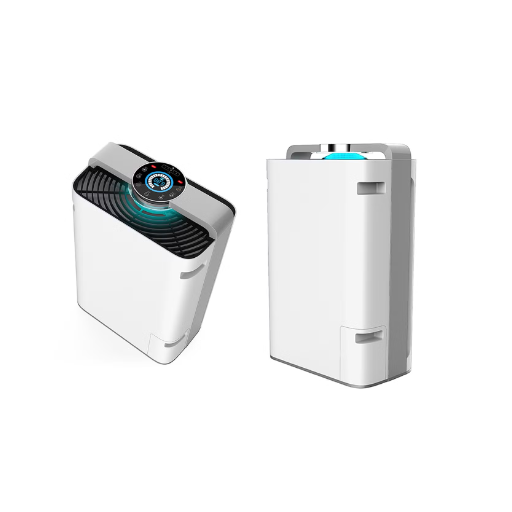
Mechanism of a Humidifier
A humidifier increases moisture in the air, which makes the indoor atmosphere more vibrant and pleasant, especially in dry climates or during cold seasons when heating tends to reduce humidity levels. Several types of humidifiers are available, each possessing a different operating mechanism:
- Evaporative Humidifiers: Air is drawn by a fan through a wet wick or filter. Water evaporates off the filter, moistening the air. The process is self-regulating, meaning the evaporation rate decreases as the humidity increases.
- Ultrasonic Humidifiers: These use high-frequency vibrations to break water up into tiny droplets, which are then released as a mist. Silent and very energy-efficient, these are perhaps the most popular type of humidifiers.
- Steam Vaporizers (Warm Mist Humidifiers): Water is heated to create a steam vapor, which is then cooled slightly before being released into the atmosphere. Because the heating process can kill bacteria and allergens, these vaporizers may also be utilized for treatments.
- Impeller Humidifiers: By using the rotating disk, the dissipation of free dropping of cool mist is formed by flinging water at a diffuser. The diffuser disperses enough moisture into the air.
Each one of them has advantages and disadvantages, and the choice depends on personal preferences such as room size or sensitivity to noise, or specific medical needs. Most of the humidifiers require regular cleaning to prevent the growth of mold, bacteria, and mineral deposits. Recent studies have suggested that indoor humidity from 30% to 50% can mitigate some respiratory conditions and improve air quality in general.
Mechanism of a Dehumidifier
The general purpose of a dehumidifier is to collect excess moisture from the air, thus bringing comfort to the indoor environment and also preventing high-humidity-related problems such as mold or structural damage. Starting with the basic mechanism, air enters the dehumidifier with the help of a fan. Inside, the air is cooled down as it passes over the coils or refrigerated surface.
Since the temperature of the coils is below the dew point, moisture in the air condenses into water, which drips into a collection tank or exits via a drainage outlet. With moisture gone, the dry air passes over comparatively hot coils, known as the condenser, to make sure the air will not be returned to the room feeling uncomfortably cold.
Most modern dehumidifiers utilize integrated sensors to measure indoor humidity and regulate their operation automatically to uphold the target humidity level, conventionally falling between 30% and 50%. This level is deemed ideal for health and comfort, as well as for the protection of furniture, electronics, and walls.
Mechanism of an Air Purifier
Air purifiers are devices that help remove dangerous pollutants from the air, providing a cleaner and healthier indoor environment. Essentially, an air purifier pulls air into its body, which passes through various filters that trap different particles.
Most often, the most important component in an air purifier is the High-Efficiency Particulate Air (HEPA) filter that captures particles 0.3 microns or larger, like dust, pollen, mold spores, and even some bacteria. Some models have pre-filters that collect larger particles, such as pet hair, so that the primary filter does not clog.
Advanced air purifiers may include:
- Activated Carbon Filters: Absorb odors, chemicals, and VOCs from the air
- UV-C Light: Disinfect airborne pathogens for better respiratory health
- Ionizers: Use charged particles to attach to contaminants, causing them to fall out of the air
- Electrostatic Precipitators: Similar to ionizers, they help remove particles from the air
When to Use Each Device
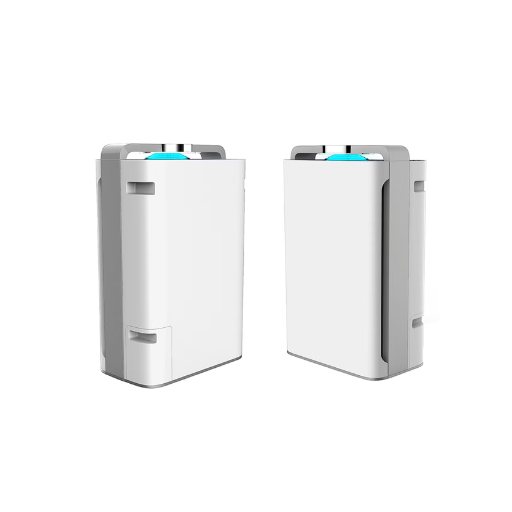
Using a Humidifier in Dry Air Conditions
In winter months and arid situations, a humidifier is a must-have to be used if dry air conditions prevail outside. The dry air can entail dryness in the skin, irritation of the nose and throat, or difficulty sleeping. A humidifier pours moisture into the air and creates a warm and comfortable environment to make people feel better, alleviating their discomfort.
Signs you need a humidifier:
- Static electricity buildup
- Wilting houseplants
- Increased respiratory tract irritation
- Dry skin and throat
- Difficulty sleeping due to dryness
Keep the indoor humidity level in the range of 30-50%, which is the right measure for health and comfort. This ensures you avoid very low humidity while preventing excessive moisture that encourages mold or mildew.
Using a Dehumidifier in Humid Environments
A dehumidifier is very helpful for reducing moisture-bearing humidity in humid zones, because high humidity is uncomfortable; it invites health hazards and structural damages. Excess moisture is favorable for mold and dust mites; mold and dust mites are household allergens and great respiratory hazards.
Signs you need a dehumidifier:
- Soils are always damp
- Musty odors
- Condensation on windowpanes
- Slime on walls and around windows
- Damage to wooden furniture and electronics
Present-day dehumidifiers with modern features make these appliances more efficient and user-friendly. Many now come equipped with digital humidity meters (humidistats), energy-saving features, automatic shut-off, Wi-Fi connectivity, and quiet operation.
Using an Air Purifier for Allergy Relief
Considered an important tool for anyone who needs relief from allergies, an air purifier takes airborne allergens and pollen, dust mites, pet dander, molds, etc., and traps them. HEPA filters are highly effective in capturing particles down to the size of 0.3 microns and thus remove most common allergens existing in indoor air.
Best conditions for air purifier use:
- High pollen seasons
- Homes with pets
- Areas with poor outdoor air quality
- For people with asthma or allergic rhinitis
- Removing odors and VOCs
Advanced models incorporated activated carbon filters capable of odor and VOC removal, providing dual benefits – relief from allergy symptoms and freshening of the air.
Comparing Humidifiers, Dehumidifiers, and Air Purifiers
Air Quality Impact: Comprehensive Comparison
| Key Point | Humidifier | Dehumidifier | Air Purifier |
|---|---|---|---|
| Function | Adds moisture | Removes moisture | Filters particles |
| Air Quality | Prevents dryness | Reduces humidity | Removes allergens |
| Best For | Dry climates | Humid climates | Polluted air |
| Health Impact | Eases dry skin | Prevents mold growth | Reduces allergies |
| Usage | Winter | Summer | Year-round |
| Energy Use | Low | Moderate | Moderate |
| Maintenance | Clean tank | Empty water tank | Replace filters |
| Noise Level | Low | Moderate | Low to moderate |
| Placement | Bedroom | Basement | Living room |
| Cost | Low to moderate | Moderate | Moderate to high |
Energy Consumption Analysis
Energy consumption evaluation between a humidifier, dehumidifier, and air purifier depends on how they work and their efficiency:
- Humidifiers: Generally use the least energy as they are intended to be used intermittently, especially during cold weather. Electric bills should not increase significantly.
- Dehumidifiers: May employ a compressor or chemicals to absorb moisture, which means more energy consumption. Energy consumption tends to spike in summertime and in damp climates.
- Air Purifiers: Consume moderate electrical energy depending on their working mechanism of fans and filters. Advanced models with HEPA filters and UV-C lights can consume more electricity, but the cost is usually offset by year-round usefulness.
Energy-efficient models in combination with programmable timers and smart device integration can help maximize electricity usage efficiency in all air quality appliances.
Maintenance and Efficiency

Maintaining a Humidifier
Regular humidifier maintenance keeps the equipment functioning efficiently and providing optimal air quality. Without regular cleaning, the humidifier can serve as a bacterial and mold breeding ground.
Maintenance checklist:
- Clean weekly with a white vinegar and water solution
- Replace filters every 1-3 months (varies by manufacturer)
- Use distilled or demineralized water to minimize mineral deposits
- Rinse tank thoroughly to eliminate residual odor or taste
- Keep the surrounding area free from moisture
- Follow the manufacturer’s usage instructions
Maintaining a Dehumidifier
Your dehumidifier should receive proper care and upkeep to remain efficient and long-lasting.
Maintenance checklist:
- Clean or replace the air filter regularly
- Empty the condensate water container every time
- Check continuous drain outlets for obstructions
- Clean coils periodically to remove dust and dirt
- Ensure proper air circulation around the unit
- Keep the room temperature within the stipulated range
- Schedule regular maintenance service inspections
Maintaining an Air Purifier
Proper maintenance ensures air purifiers operate at optimum efficiency with increased lifespan.
Maintenance checklist:
- Replace HEPA filters every 6-12 months
- Wash or replace pre-filters more frequently
- Clean exterior and vents regularly
- Keep sensors clean and dust-free
- Service UV light bulbs or ionic plates as needed
- Ensure proper air circulation around the unit
- Follow the manufacturer’s guidelines for usage and care
Frequently Asked Questions (FAQ)
References
- Air Filters, Dehumidifiers, and Humidifiers – This resource examines the uses and benefits of dehumidifiers, humidifiers, and air purifiers, especially concerning health and indoor air quality.
- Development and Performance Evaluation of an Intelligent Air Purifier/Humidifier System – This academic paper reviews the design and performance of air purifier and humidifier systems, emphasizing their importance for indoor air quality.
- Top 5 Dorm Room Essentials – According to this TCU article, air purifiers, humidifiers, and dehumidifiers may be found in dorm rooms because of their importance in maintaining a comfortable and healthy living environment.

